
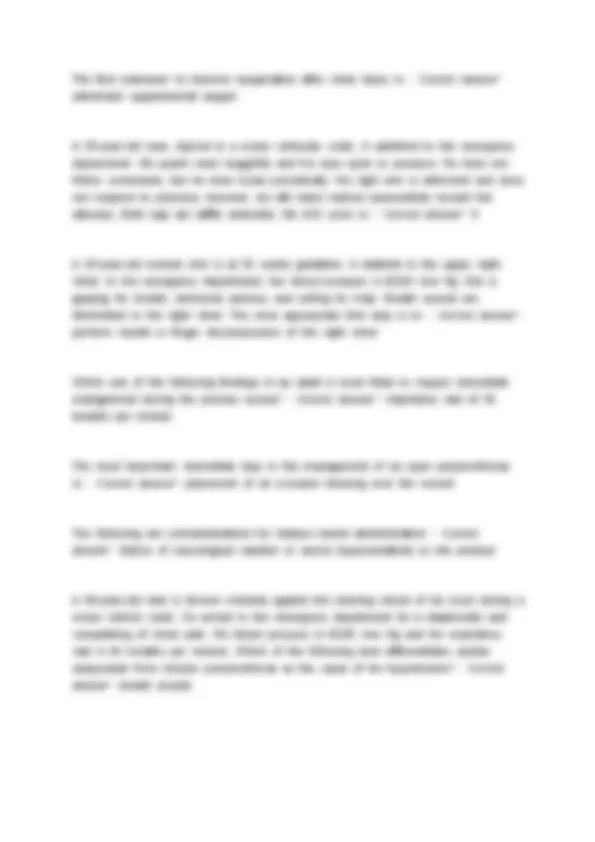
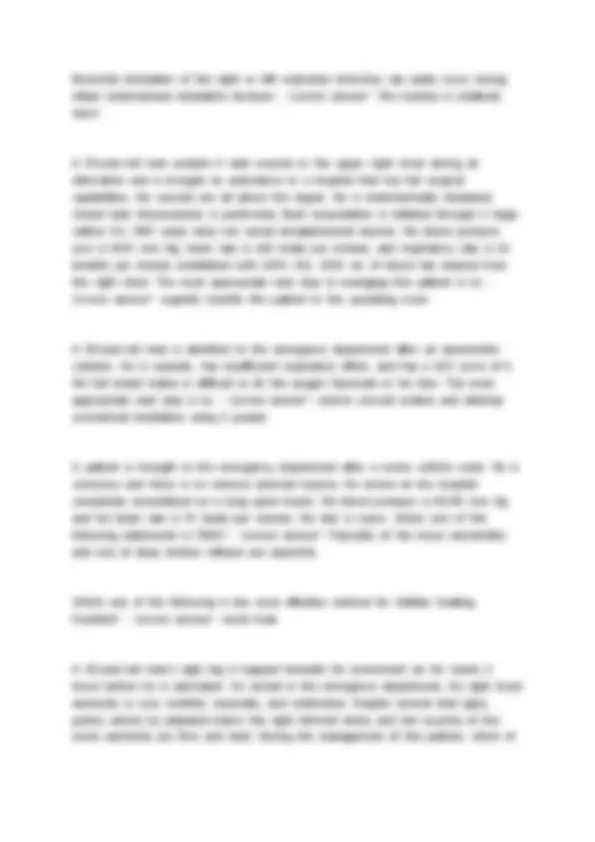
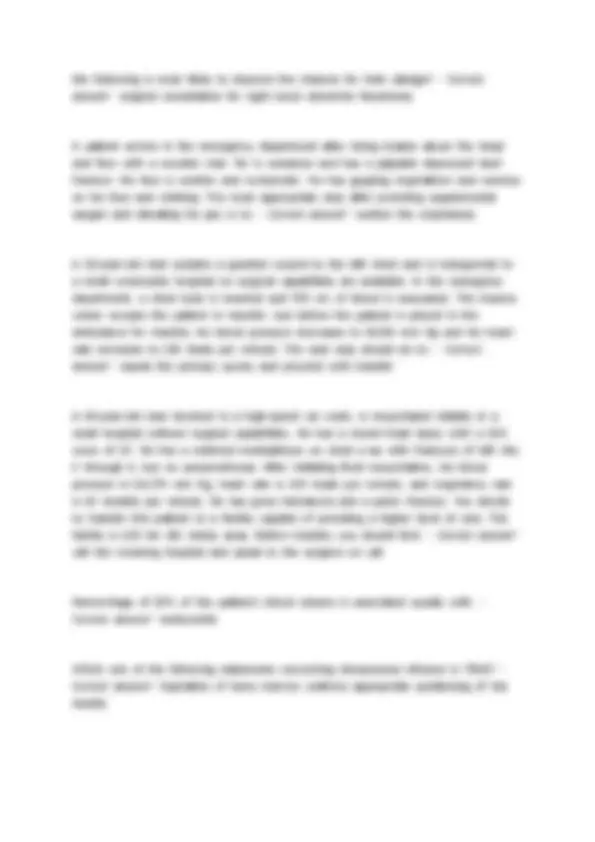
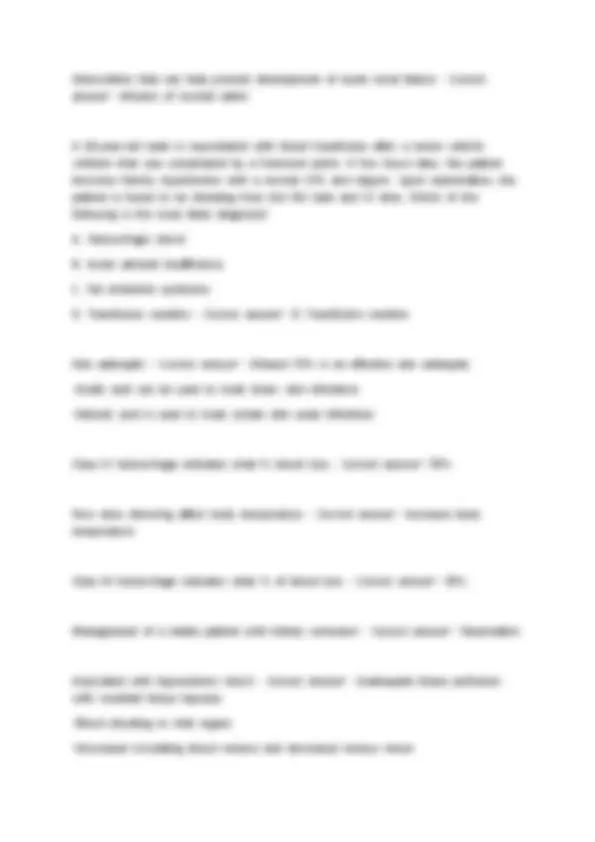

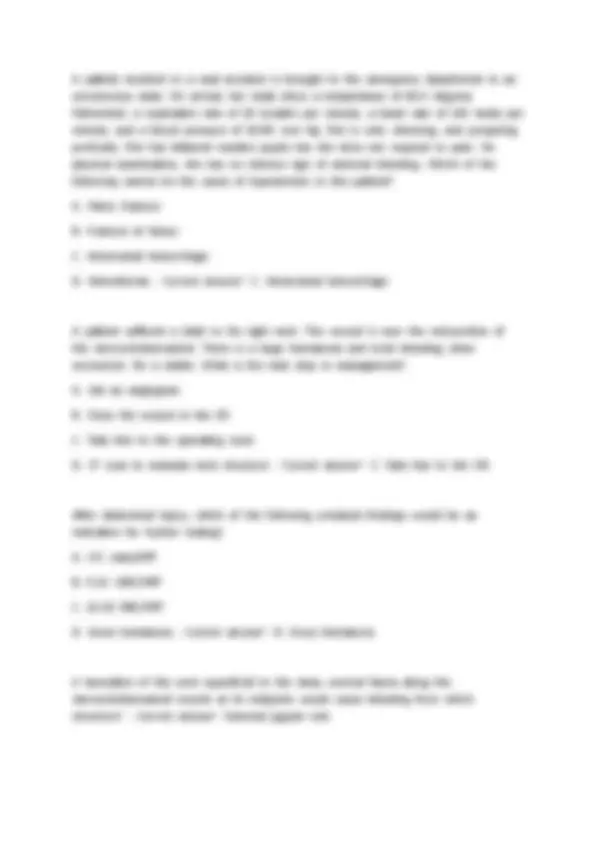
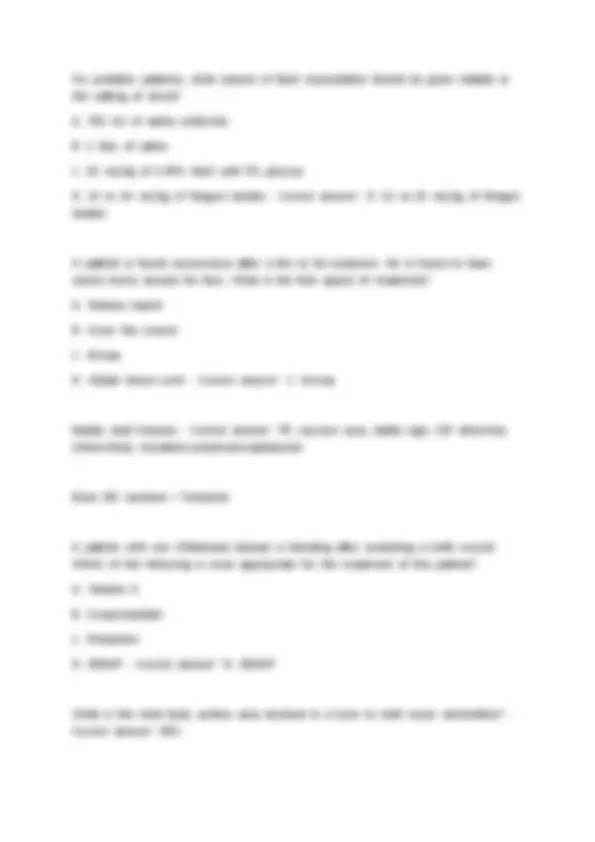
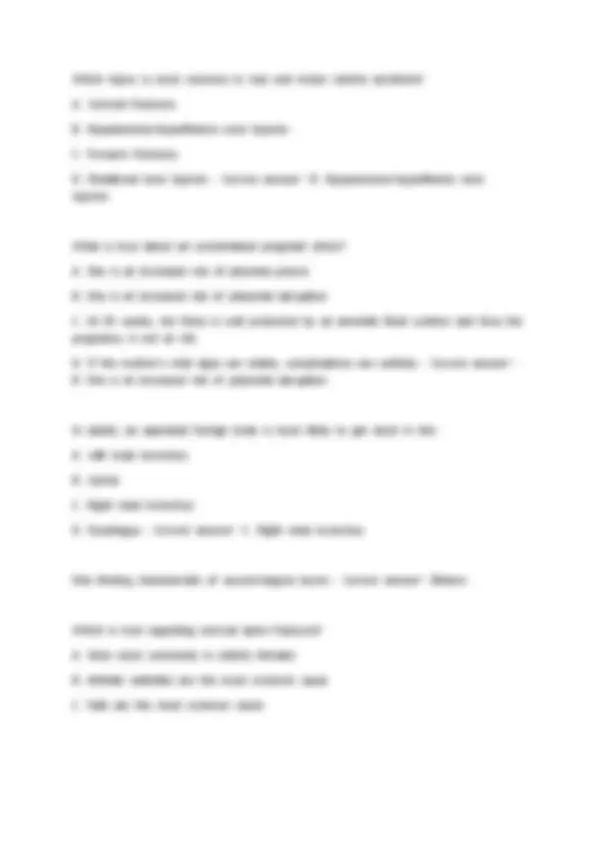
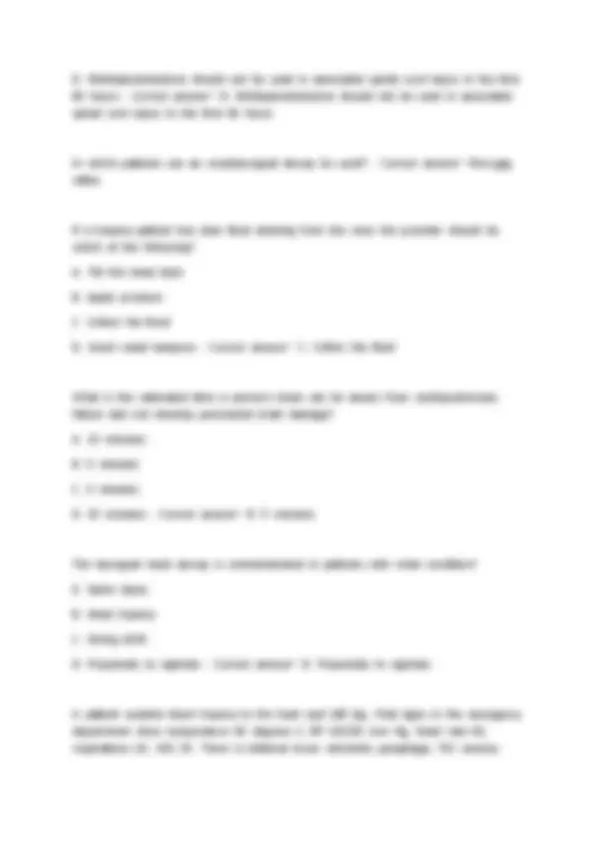
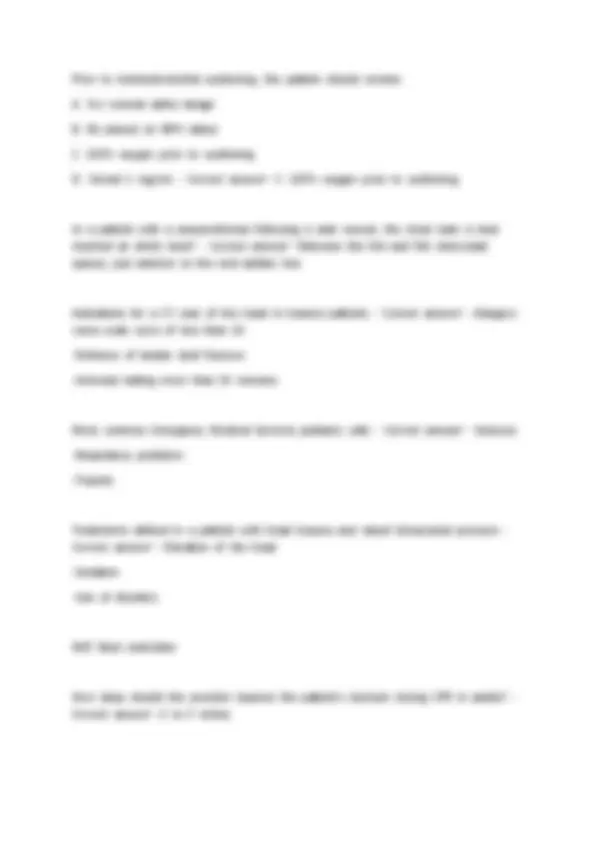
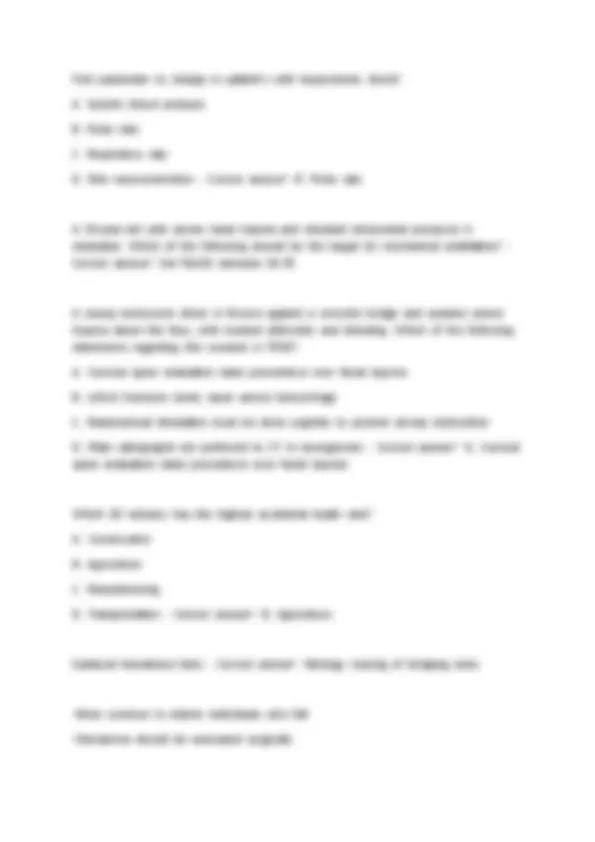
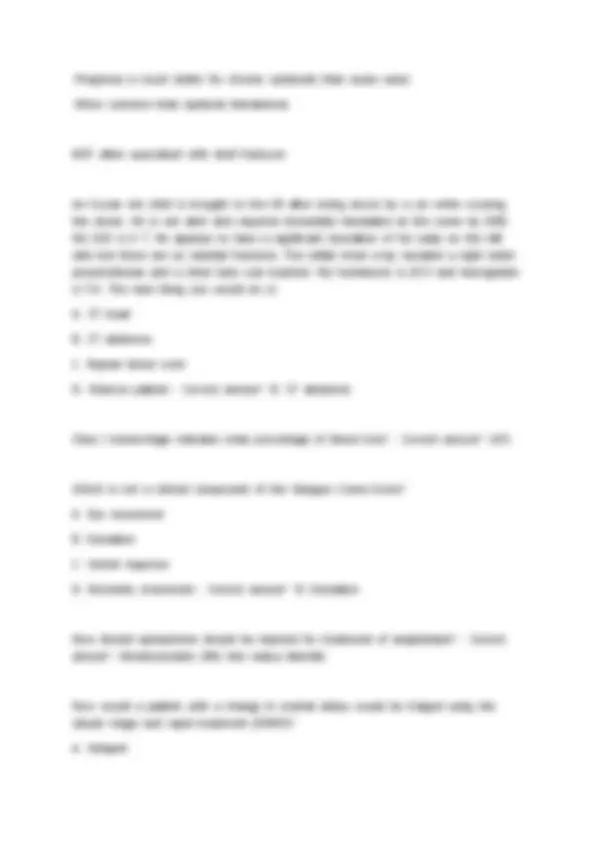
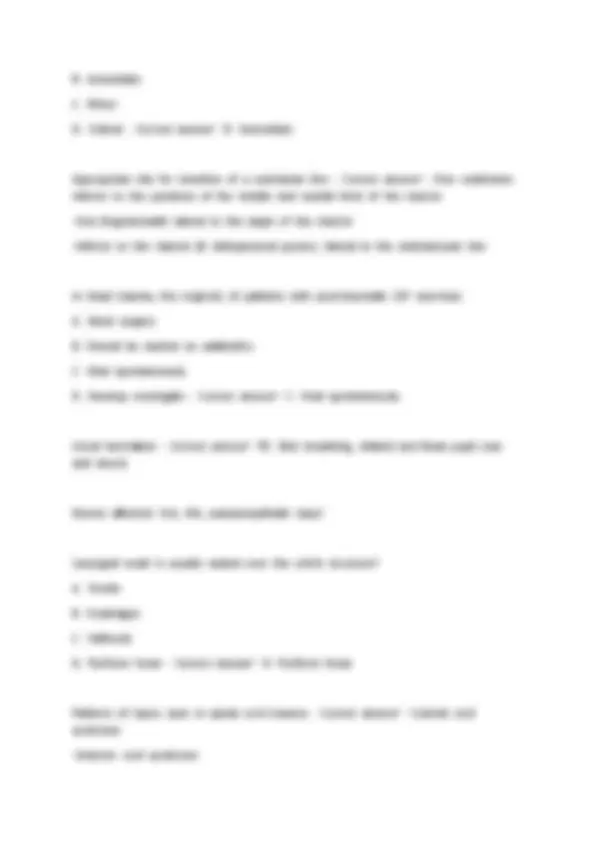
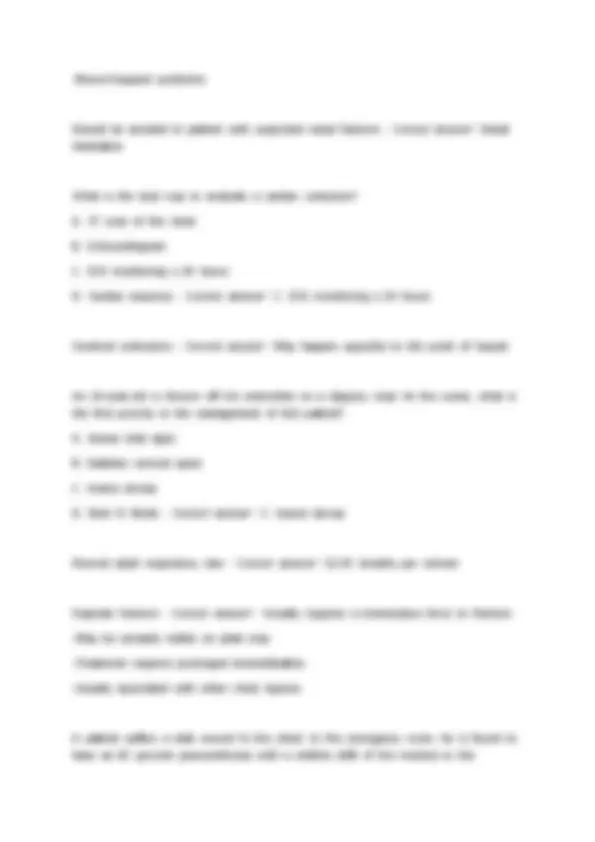
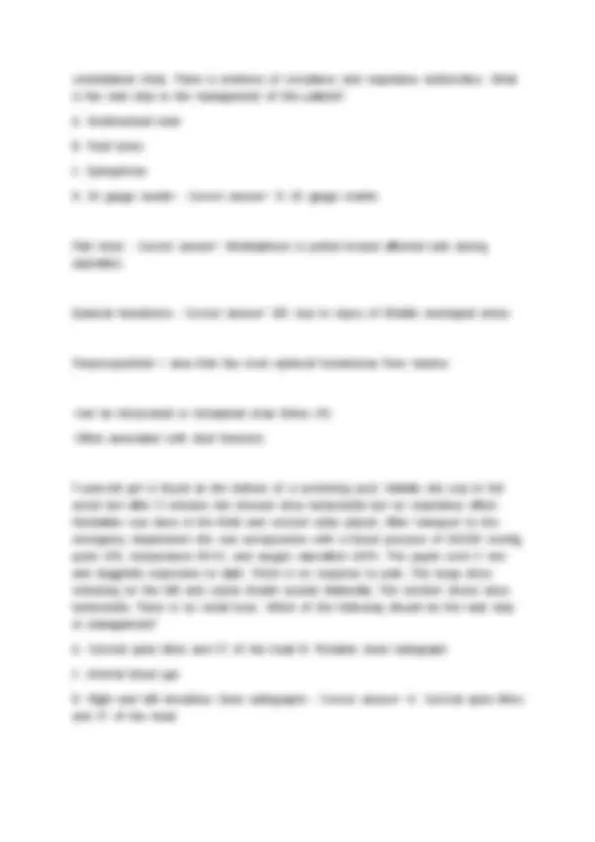

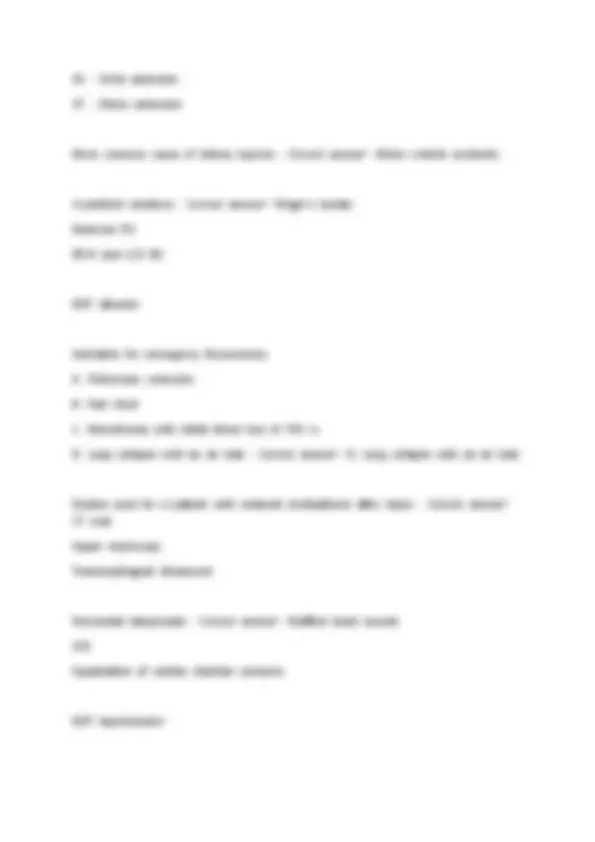
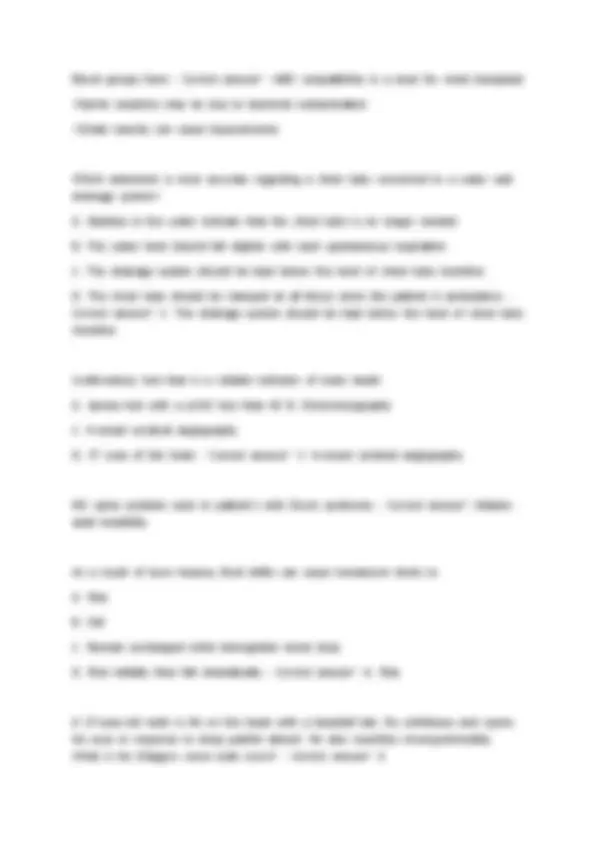

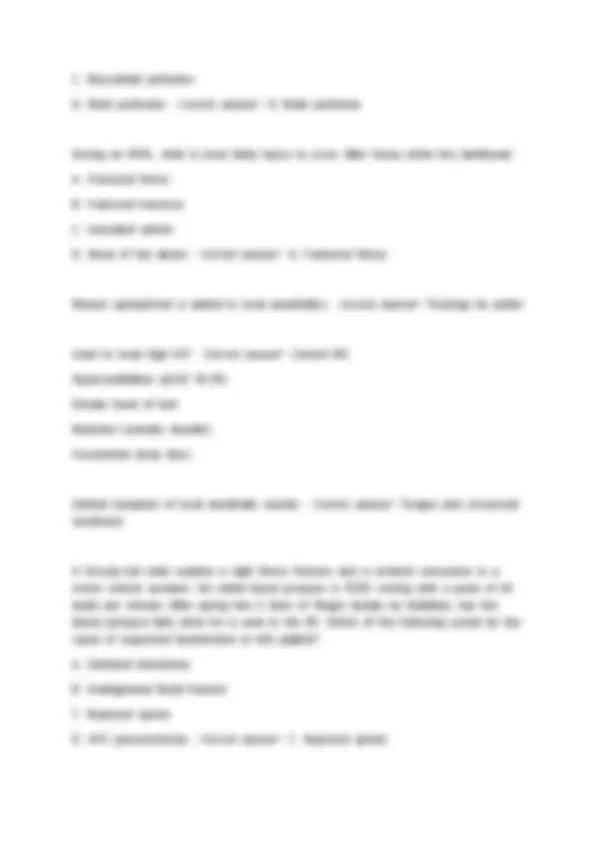
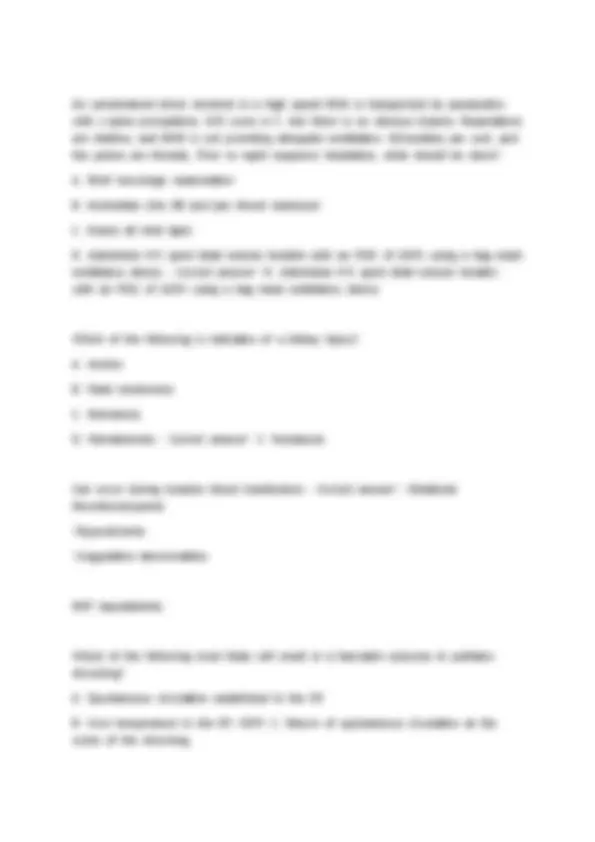
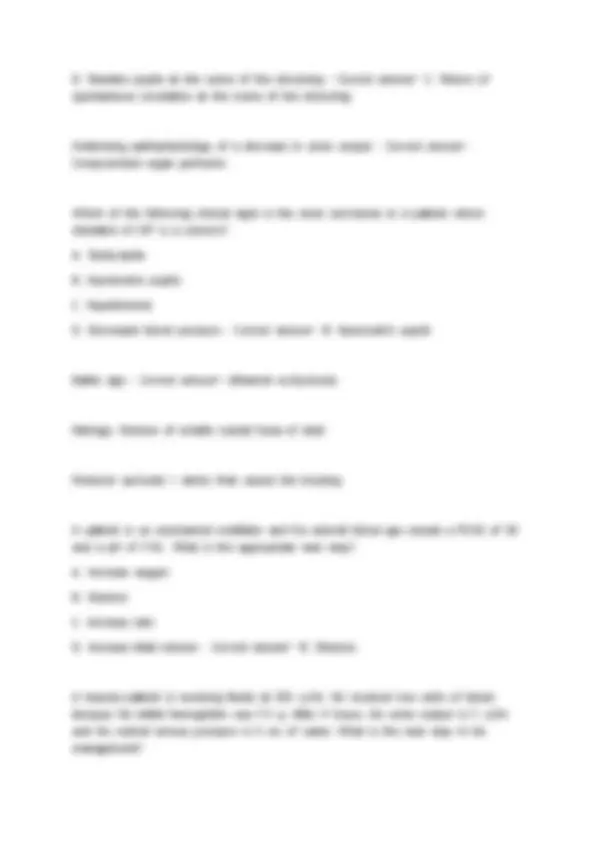
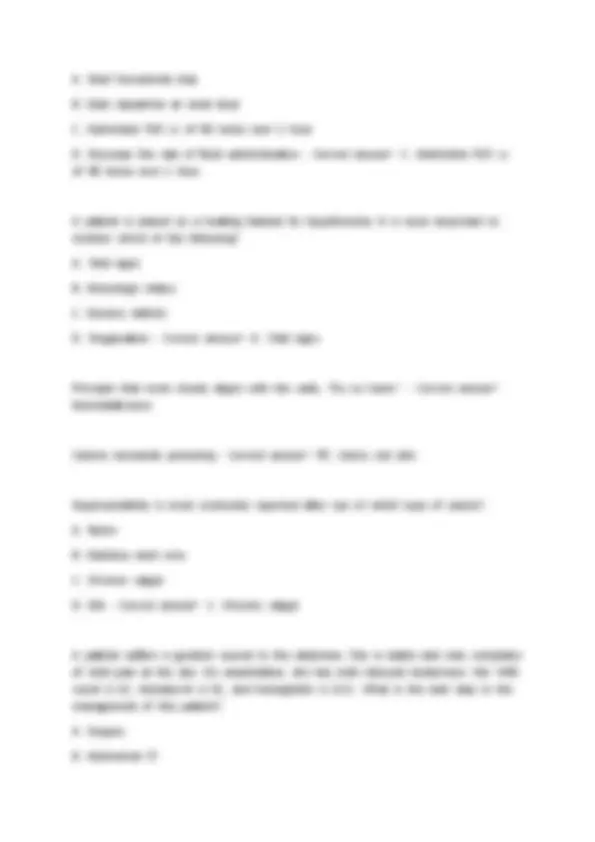
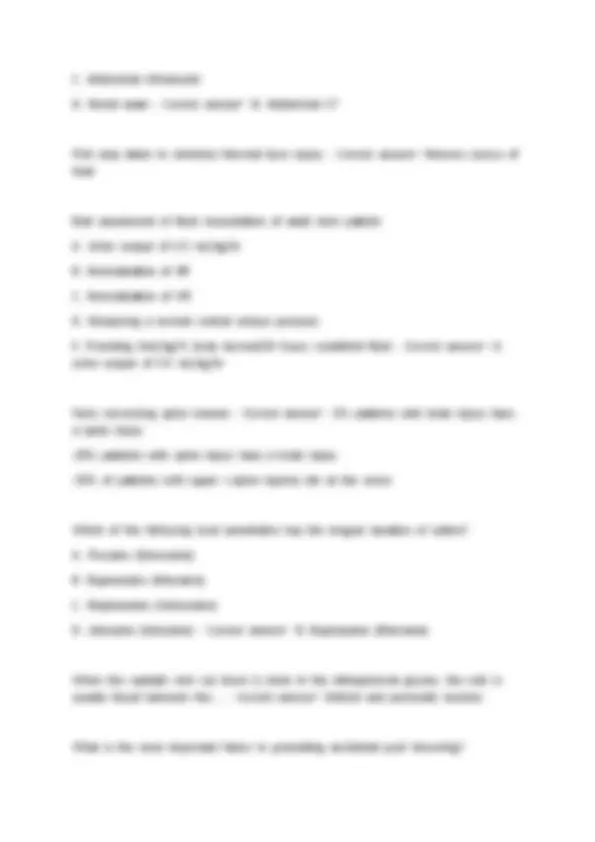
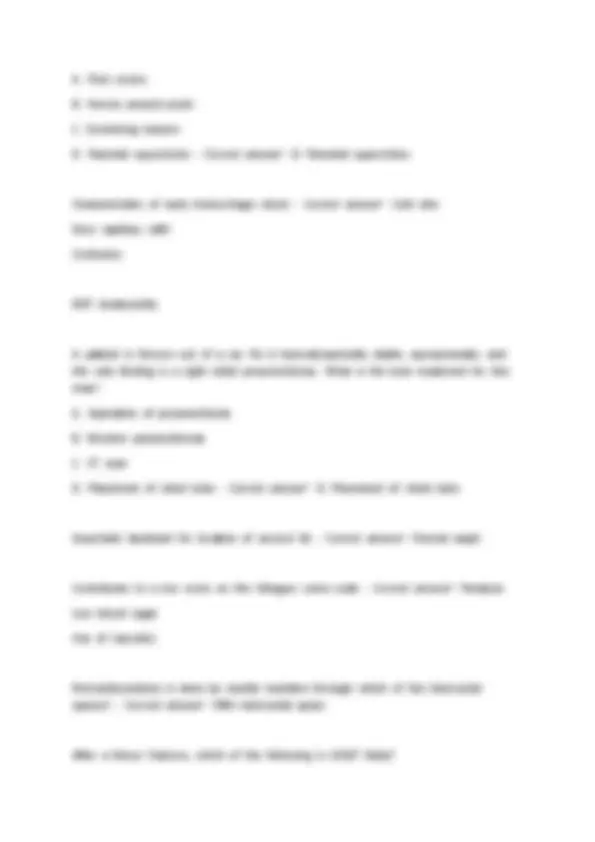
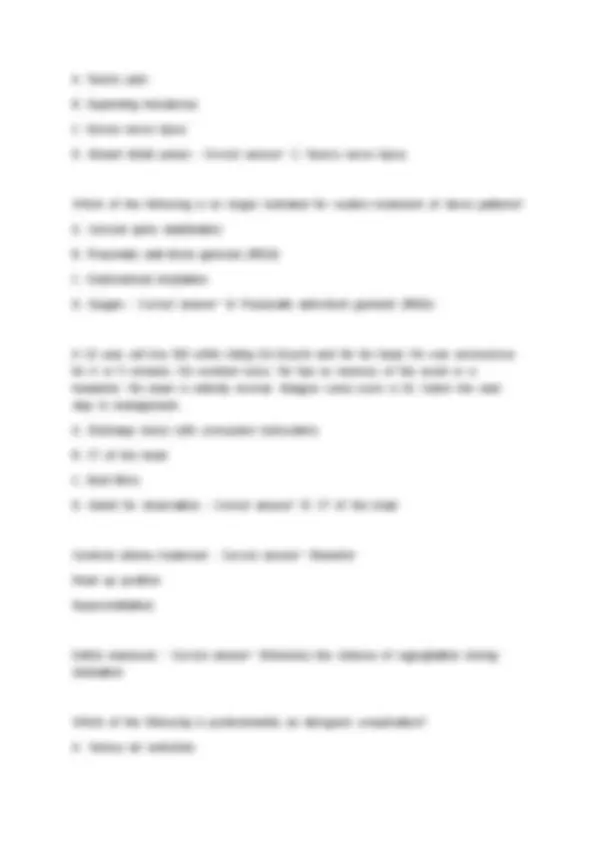
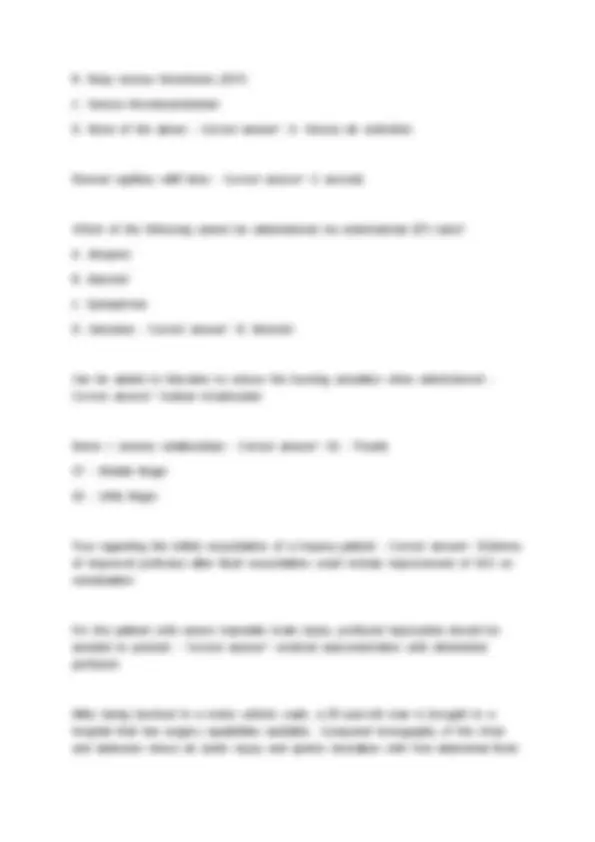
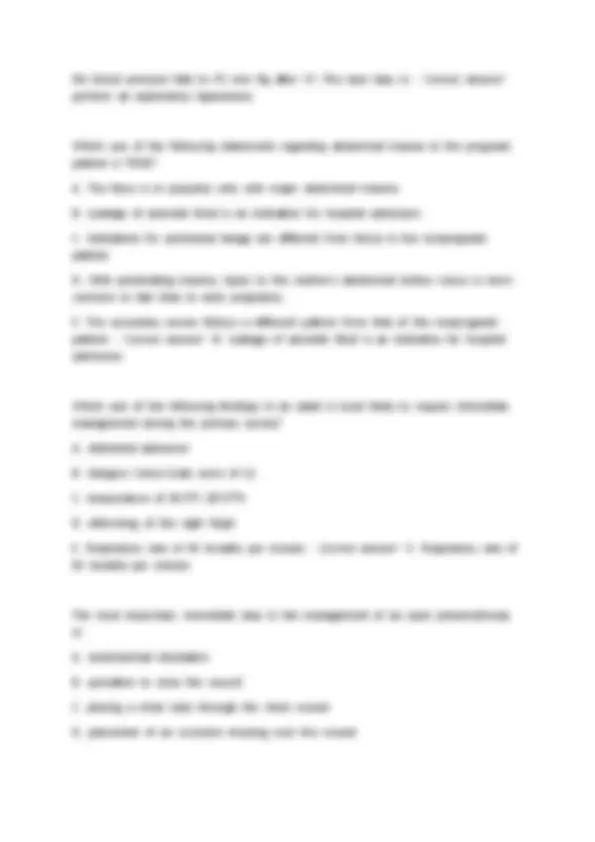
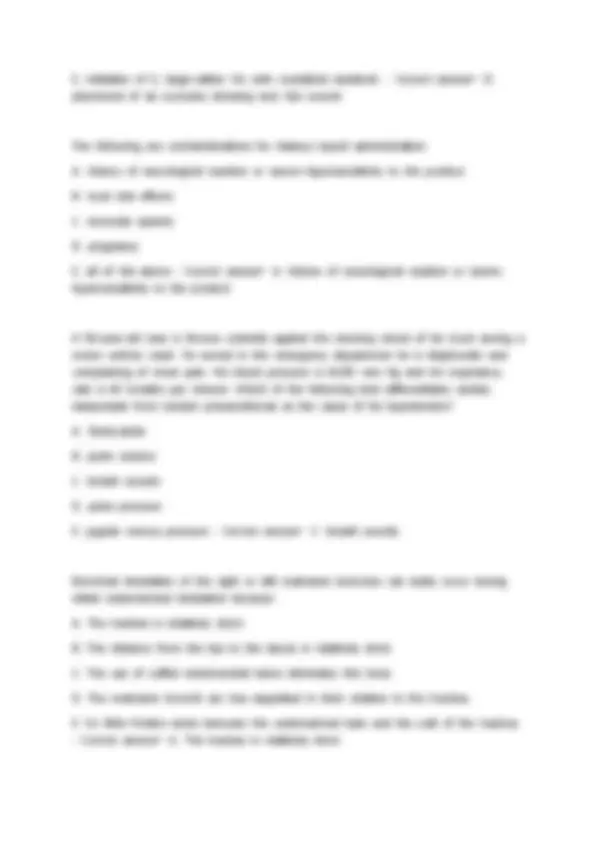
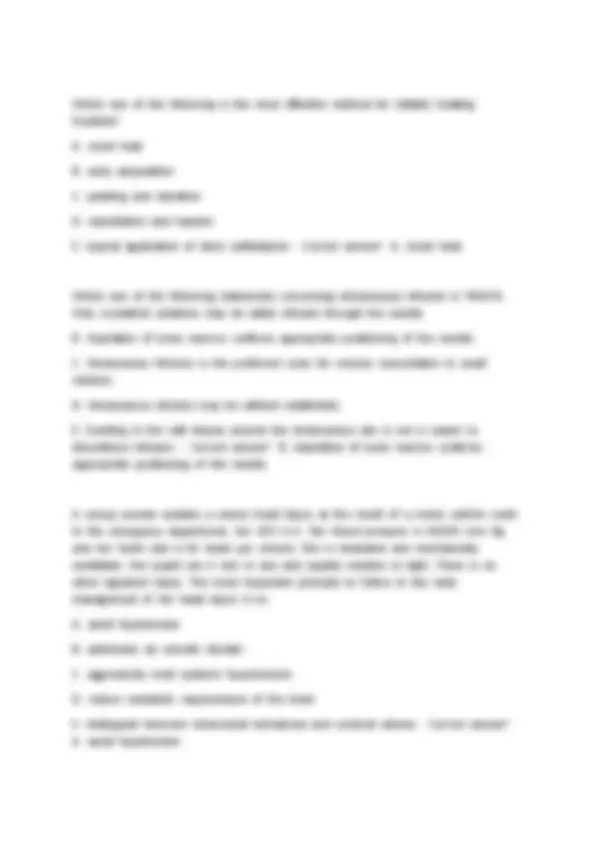
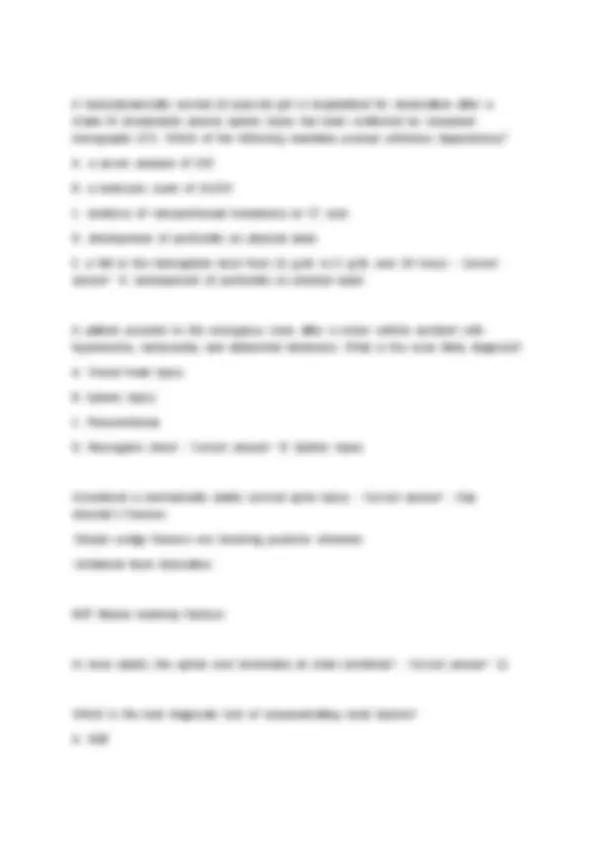

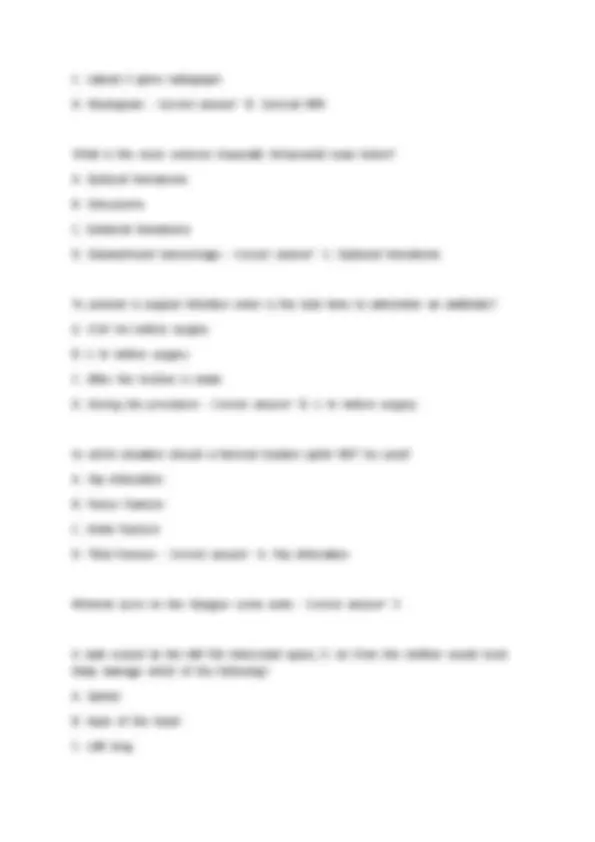
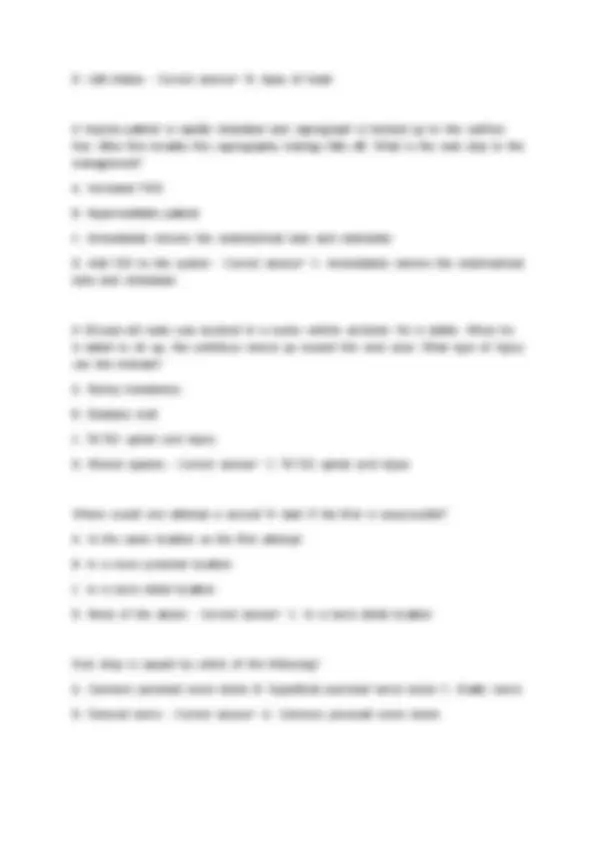
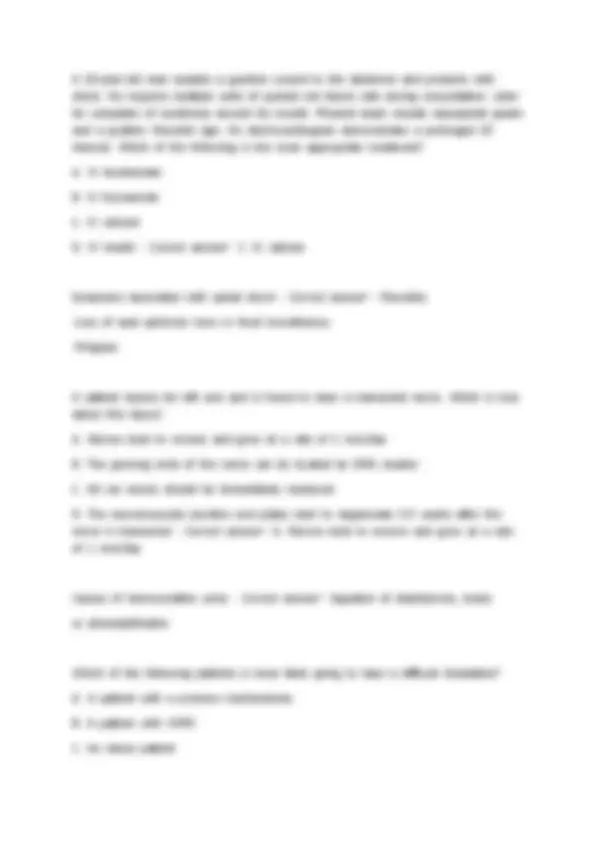
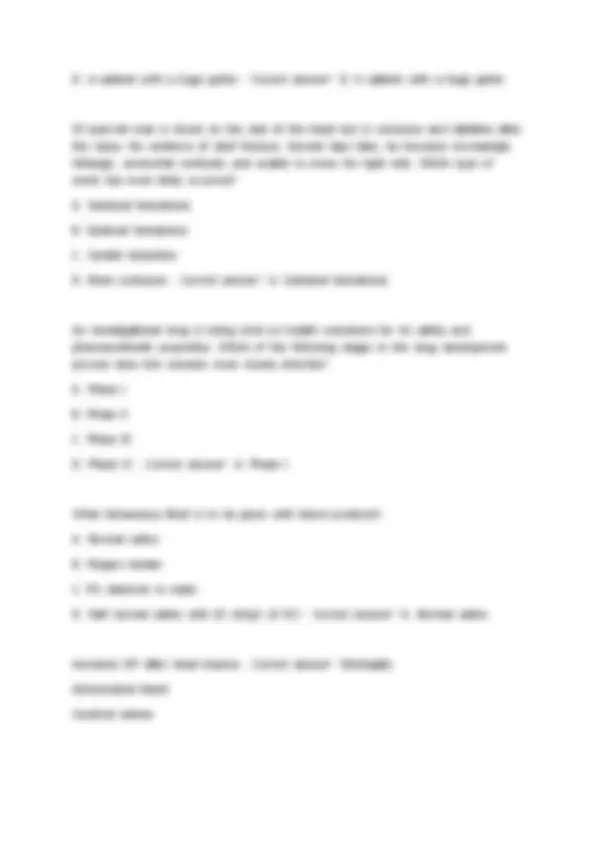
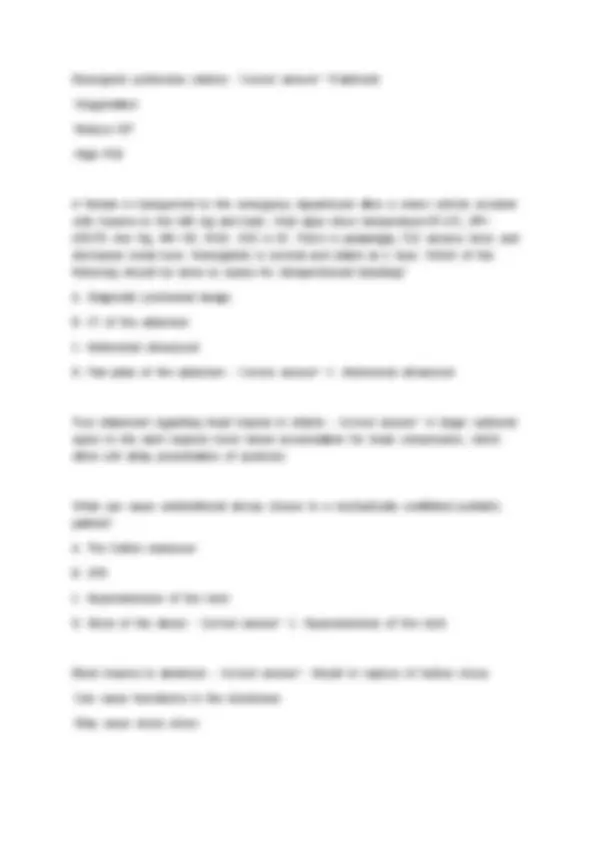
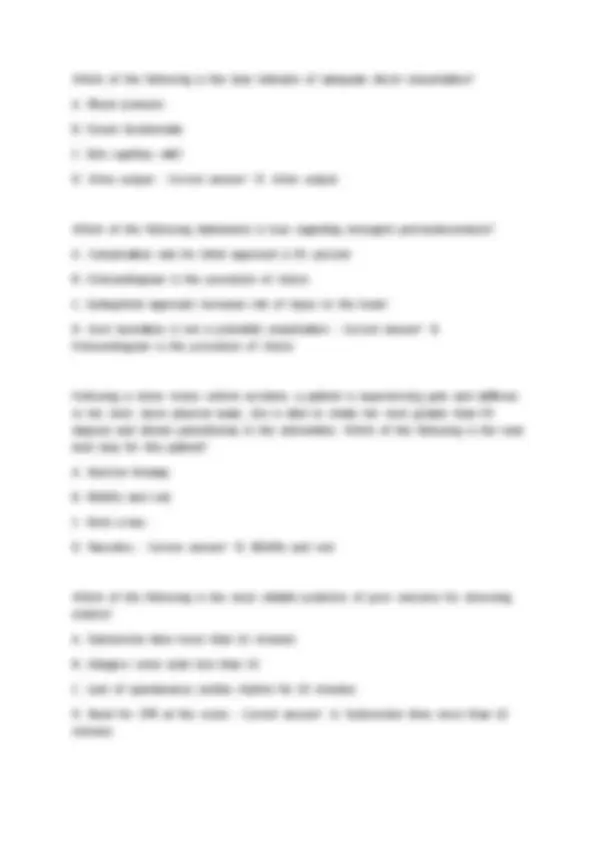
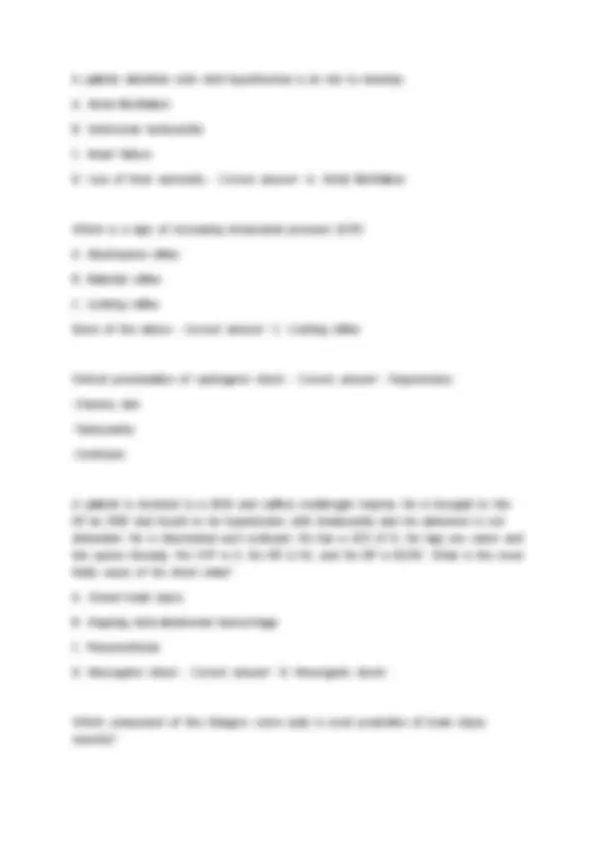
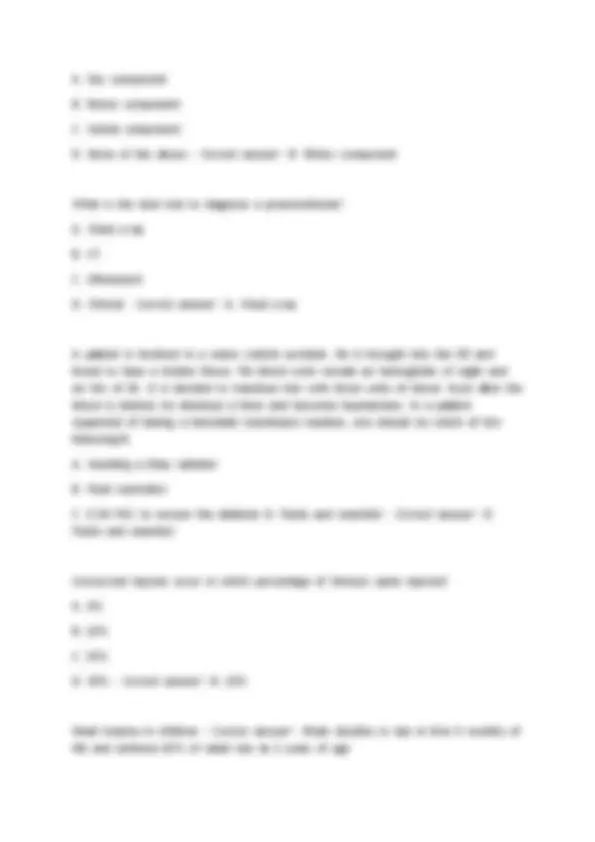
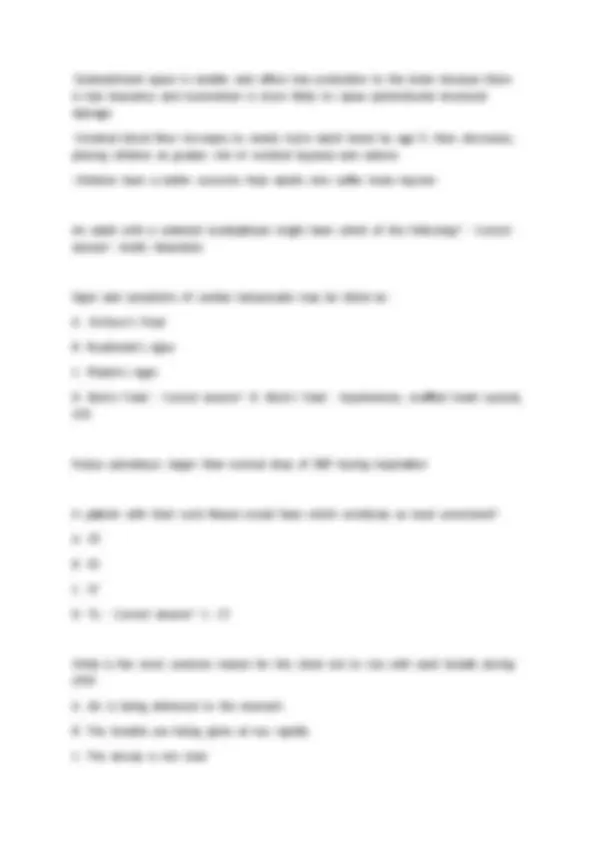
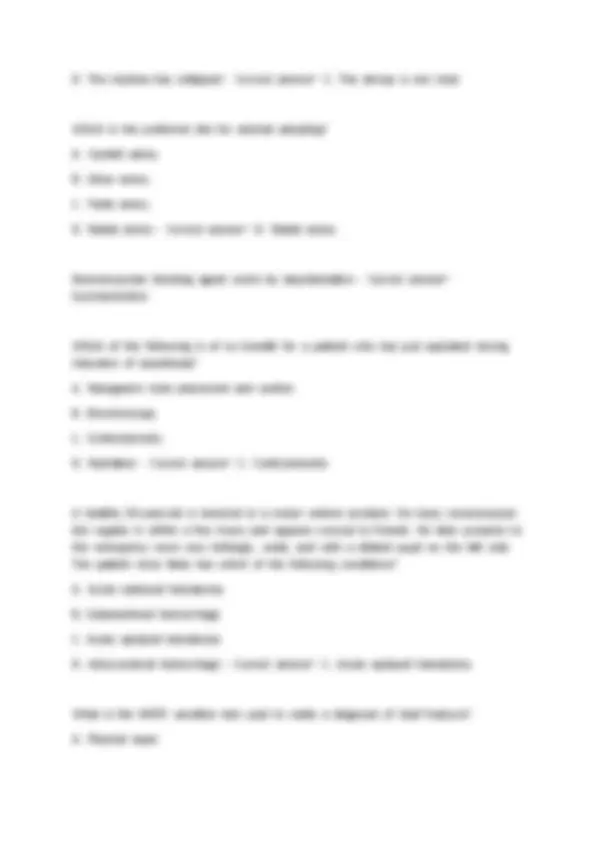
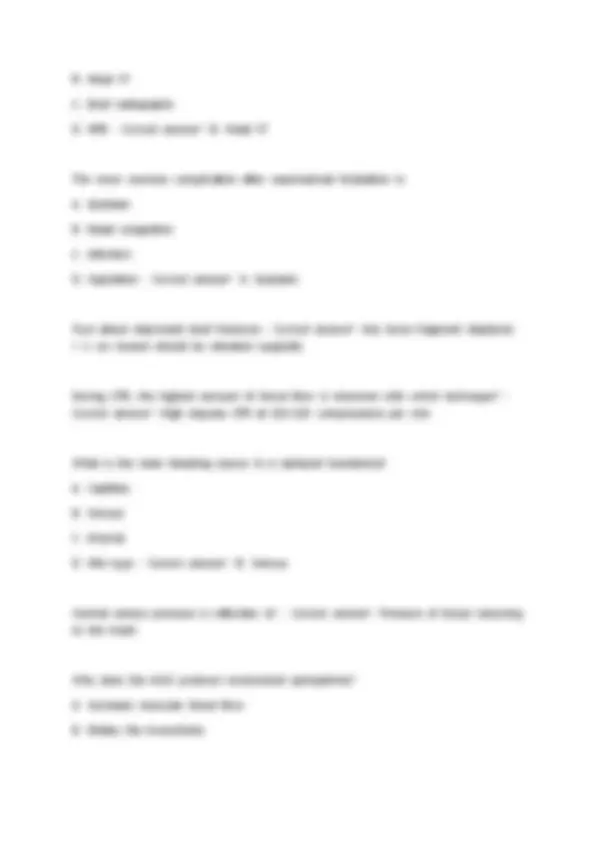
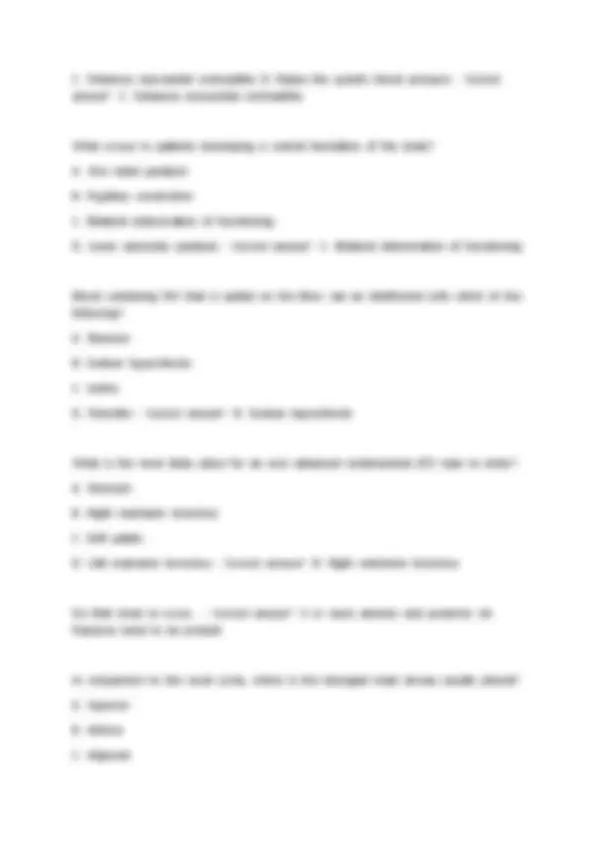
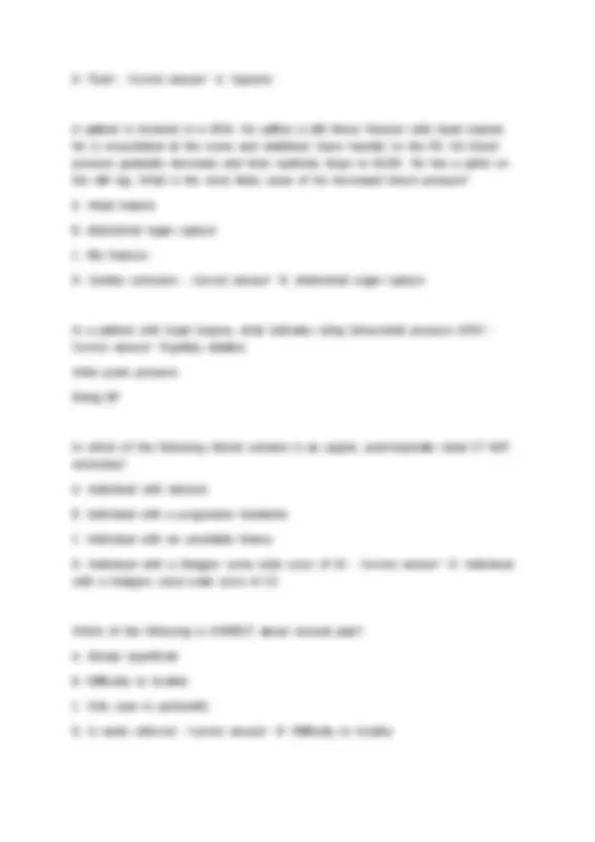
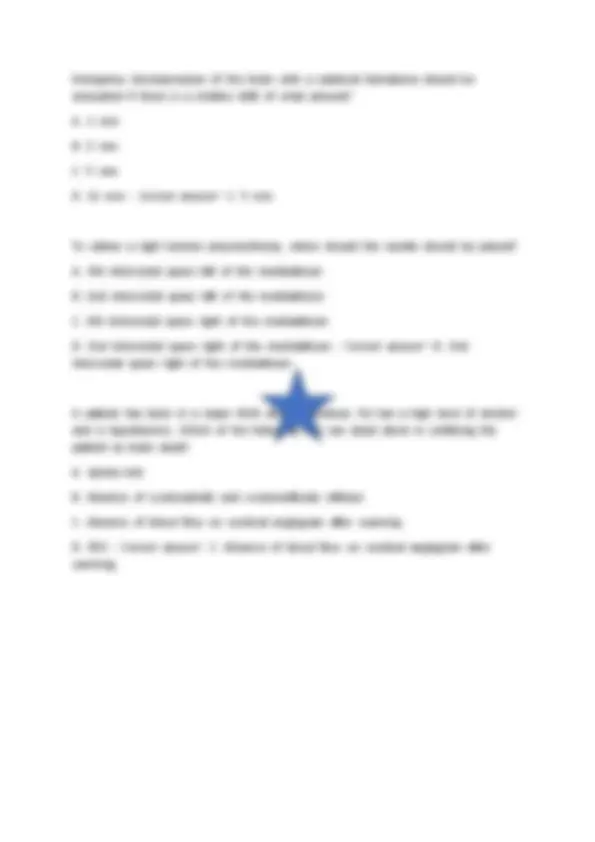


Study with the several resources on Docsity

Earn points by helping other students or get them with a premium plan


Prepare for your exams
Study with the several resources on Docsity

Earn points to download
Earn points by helping other students or get them with a premium plan
Community
Ask the community for help and clear up your study doubts
Discover the best universities in your country according to Docsity users
Free resources
Download our free guides on studying techniques, anxiety management strategies, and thesis advice from Docsity tutors
ATLS PRACTICE TEST 2024/2025.pdf
Typology: Exams
1 / 54

This page cannot be seen from the preview
Don't miss anything!















































A 22 - year-old man is hypotensive and tachycardic after a shotgun wound to the left shoulder. His blood pressure is initially 80/40 mm Hg. After initial fluid resuscitation his blood pressure increases to 122/84 mm Hg. His heart rate is now 100 beats per minute and his respiratory rate is 28 breaths per minute. A tube thoracostomy is performed for decreased left chest breath sounds with the return of a small amount of blood and no air leak. After chest tube insertion, the most appropriate next step is: - Correct answer~ re-examine the chest A construction worker falls two stories from a building and sustains bilateral calcaneal fractures. In the emergency department, he is alert, vital signs are normal, and he is complaining of severe pain in both heels and his lower back. Lower extremity pulses are strong and there is no other deformity. The suspected diagnosis is most likely to be confirmed by: - Correct answer~ complete spine x-ray series Which of the following is true regarding the initial resuscitation of a trauma patient?
A previously healthy, 70 - kg (154-pound) man suffers an estimated acute blood loss of 2 liters. Which one of the following statements applies to this patient? - Correct answer~ An ABG would demonstrate a base deficit between - 6 and - 10 mEq/L. The physiological hypervolemia of pregnancy has clinical significance in the management of the severely injured, gravid woman by: - Correct answer~ increasing the volume of blood loss to produce maternal hypotension The best assessment of fluid resuscitation of the adult burn patient is: - Correct answer~ urinary output of 0.5 mL/kg/hr The diagnosis of shock must include: - Correct answer~ evidence of inadequate organ perfusion A 7 - year-old boy is brought to the emergency department by his parents several minutes after he fell through a window. He is bleeding profusely from a 6 - cm wound of his medial right thigh. Immediate management of the wound should consist of: - Correct answer~ direct pressure on the wound For the patient with severe traumatic brain injury, profound hypocarbia should be avoided to prevent: - Correct answer~ cerebral vasoconstriction with diminished perfusion After being involved in a motor vehicle crash, a 25 - year-old man is brought to a hospital that has surgery capabilities available.. Computed tomography of the chest and abdomen shows an aortic injury and splenic laceration with free abdominal fluid. His blood pressure falls to 70 mm Hg after CT. The next step is: - Correct answer~ perform an exploratory laparotomy Which one of the following statements regarding abdominal trauma in the pregnant patient is TRUE? - Correct answer~ Leakage of amniotic fluid is an indication for hospital admission.
Bronchial intubation of the right or left mainstem bronchus can easily occur during infant endotracheal intubation because: - Correct answer~ The trachea is relatively short. A 23 - year-old man sustains 4 stab wounds to the upper right chest during an altercation and is brought by ambulance to a hospital that has full surgical capabilities. His wounds are all above the nipple. He is endotracheally intubated, closed tube thoracostomy is performed, fluid resuscitation is initiated through 2 large- caliber IVs. FAST exam does not reveal intraabdominal injuries. His blood pressure now is 60/0 mm Hg, heart rate is 160 beats per minute, and respiratory rate is 14 breaths per minute (ventilated with 100% O2). 1500 mL of blood has drained from the right chest. The most appropriate next step in managing this patient is to: - Correct answer~ urgently transfer the patient to the operating room A 39 - year-old man is admitted to the emergency department after an automobile collision. He is cyanotic, has insufficient respiratory effort, and has a GCS score of 6. His full beard makes it difficult to fit the oxygen facemask to his face. The most appropriate next step is to: - Correct answer~ restrict cervical motion and attempt orotracheal intubation using 2 people A patient is brought to the emergency department after a motor vehicle crash. He is conscious and there is no obvious external trauma. He arrives at the hospital completely immobilized on a long spine board. His blood pressure is 60/40 mm Hg and his heart rate is 70 beats per minute. His skin is warm. Which one of the following statements is TRUE? - Correct answer~ Flaccidity of the lower extremities and loss of deep tendon reflexes are expected. Which one of the following is the most effective method for initially treating frostbite? - Correct answer~ moist heat A 32 - year-old man's right leg is trapped beneath his overturned car for nearly 2 hours before he is extricated. On arrival in the emergency department, his right lower extremity is cool, mottled, insensate, and motionless. Despite normal vital signs, pulses cannot be palpated below the right femoral artery and the muscles of the lower extremity are firm and hard. During the management of this patient, which of
the following is most likely to improve the chances for limb salvage? - Correct answer~ surgical consultation for right lower extremity fasciotomy A patient arrives in the emergency department after being beaten about the head and face with a wooden club. He is comatose and has a palpable depressed skull fracture. His face is swollen and ecchymotic. He has gurgling respirations and vomitus on his face and clothing. The most appropriate step after providing supplemental oxygen and elevating his jaw is to: - Correct answer~ suction the oropharynx A 22 - year-old man sustains a gunshot wound to the left chest and is transported to a small community hospital no surgical capabilities are available. In the emergency department, a chest tube is inserted and 700 mL of blood is evacuated. The trauma center accepts the patient in transfer. Just before the patient is placed in the ambulance for transfer, his blood pressure decreases to 80/68 mm Hg and his heart rate increases to 136 beats per minute. The next step should be to: - Correct answer~ repeat the primary survey and proceed with transfer A 64 - year-old man involved in a high-speed car crash, is resuscitated initially in a small hospital without surgical capabilities. He has a closed head injury with a GCS score of 13. He has a widened mediastinum on chest x-ray with fractures of left ribs 2 through 4, but no pneumothorax. After initiating fluid resuscitation, his blood pressure is 110/74 mm Hg, heart rate is 100 beats per minute, and respiratory rate is 18 breaths per minute. He has gross hematuria and a pelvic fracture. You decide to transfer this patient to a facility capable of providing a higher level of care. The facility is 128 km (80 miles) away. Before transfer, you should first: - Correct answer~ call the receiving hospital and speak to the surgeon on call Hemorrhage of 20% of the patient's blood volume is associated usually with: - Correct answer~ tachycardia Which one of the following statements concerning intraosseous infusion is TRUE? - Correct answer~ Aspiration of bone marrow confirms appropriate positioning of the needle.
A healthy young male is brought to the emergency department following a motor vehicle crash. His vital signs are a blood pressure of 84/60, pulse 123, GCS 10. The patient moans when his pelvis is palpated. After initiating fluid resuscitation, the next step in management is: - Correct answer~ placement of a pelvic binder Which one of the following situations requires Rh immunoglobulin administration to an injured woman? - Correct answer~ positive pregnancy test, Rh negative, and has torso trauma A 22 - year-old female athlete is stabbed in her left chest at the third interspace in the anterior axillary line. On admission to the emergency department and 15 minutes after the incident, she is awake and alert. Her heart rate is 100 beats per minute, blood pressure 80/60 mm Hg, and respiratory rate 20 breaths per minute. A chest x- ray reveals a large left hemothorax. A left chest tube is placed with an immediate return of 1600 mL of blood. The next management step for this patient is: - Correct answer~ prepare for an exploratory thoracotomy A 6 - year-old boy walking across the street is struck by the front bumper of a sports utility vehicle traveling at 32 kph (20 mph). Which one of the following statements is TRUE about this patient? - Correct answer~ A pulmonary contusion may be present in the absence of rib fractures. Assessed first in trauma patient - Correct answer~ Airway (*)Degree of burn that is characterized by bone involvement - Correct answer~ Fourth Complications of head trauma - Correct answer~ Intracerebral hematoma Extradural hematoma Brain abscess Most common cause of laryngotracheal stenosis - Correct answer~ Trauma
Intervention that can help prevent development of acute renal failure - Correct answer~ Infusion of normal saline A 26 - year-old male is resuscitated with blood transfusion after a motor vehicle collision that was complicated by a fractured pelvis. A few hours later, the patient becomes febrile, hypotensive with a normal CVP, and oliguric. Upon examination, the patient is found to be bleeding from the NG tube and IV sites. Which of the following is the most likely diagnosis? A. Hemorrhagic shock B. Acute adrenal insufficiency C. Fat embolism syndrome D. Transfusion reaction - Correct answer~ D. Transfusion reaction Skin antiseptic - Correct answer~ - Ethanol 70% is an effective skin antiseptic
A patient involved in a road accident is brought to the emergency department in an unconscious state. On arrival, her vitals show a temperature of 96.4 degrees Fahrenheit, a respiration rate of 24 breaths per minute, a heart rate of 140 beats per minute, and a blood pressure of 80/40 mm Hg. She is cold, shivering, and perspiring profusely. She has bilateral reactive pupils but she does not respond to pain. On physical examination, she has no obvious sign of external bleeding. Which of the following cannot be the cause of hypotension in this patient? A. Pelvic fracture B. Fracture of femur C. Intracranial hemorrhage D. Hemothorax - Correct answer~ C. Intracranial hemorrhage A patient suffered a slash to his right neck. The wound is over the mid-portion of the sternocleidomastoid. There is a large hematoma and brisk bleeding when uncovered. He is stable. What is the next step in management? A. Get an angiogram B. Close the wound in the ER C. Take him to the operating room D. CT scan to evaluate neck structure - Correct answer~ C. Take him to the OR After abdominal injury, which of the following urinalysis findings would be an indication for further testing? A. 0 - 5 casts/HPF B. 5 - 10 WBC/HPF C. 10 - 20 RBC/HPF D. Gross hematuria - Correct answer~ D. Gross hematuria A laceration of the neck superficial to the deep cervical fascia along the sternocleidomastoid muscle at its midpoint would cause bleeding from which structure? - Correct answer~ External jugular vein
Clinical features associated with tension pneumothorax - Correct answer~ Unilateral decrease in breath sounds Hyperresonance Respiratory distress Tachycardia Tracheal shift Desatruation Decreased breath sounds Decreased compliance Asymmetric chest movement NOT hypertension, audible bronchial sounds Not recommended as a mode of ventilation for a patient with a diaphragmatic hernia A. Bag and mask B. LMA C. Endotracheal intubation D. Jet ventilation - Correct answer~ A. Bag and mask What is the next step in the assessment of a traumatic patient after airway is established? - Correct answer~ Breathing Blood group that is considered a universal donor - Correct answer~ O A provider is examining a patient who sustained a severe traumatic head injury. He documents no Doll's eyes. What does this signify? - Correct answer~ Brainstem injury Which of the following is the least preferred method of administering IV fluids? A. Cubital veins
For pediatric patients, what volume of fluid resuscitation should be given initially in the setting of shock? A. 750 mL of saline uniformly B. 1 liter of saline C. 20 mL/kg of 0.45% NaCl with 5% glucose D. 10 to 20 mL/kg of Ringers lactate - Correct answer~ D. 10 to 20 mL/kg of Ringers lactate A patient is found unconscious after a fire in his bedroom. He is found to have severe burns around his face. What is the first aspect of treatment? A. Tetanus toxoid B. Cover the wound C. Airway D. Obtain blood work - Correct answer~ C. Airway Basilar skull fracture - Correct answer~ PE: raccoon eyes, battle sign, CSF ottorrhea (rhinorrhea), loculated pneumoencephalocele Bone MC involved = Temporal A patient with von Willebrand disease is bleeding after sustaining a knife wound. Which of the following is most appropriate for the treatment of this patient? A. Vitamin K B. Cryoprecipitate C. Protamine D. DDAVP - Correct answer~ D. DDAVP What is the total body surface area involved in a burn to both lower extremities? - Correct answer~ 36%
Which injury is most common in rear end motor vehicle accidents? A. Cervical fractures B. Hypextension-hyperflexion neck injuries C. Forearm fractures D. Rotational neck injuries - Correct answer~ B. Hypextension-hyperflexion neck injuries What is true about an unrestrained pregnant driver? A. She is at increased risk of placenta previa B. She is at increased risk of placental abruption C. At 33 weeks, her fetus is well protected by an amniotic fluid cushion and thus the pregnancy is not at risk D. If the mother's vital signs are stable, complications are unlikely - Correct answer~ B. She is at increased risk of placental abruption In adults, an aspirated foreign body is most likely to get stuck in the: A. Left main bronchus B. Carina C. Right main bronchus D. Esophagus - Correct answer~ C. Right main bronchus Skin finding characteristic of second-degree burns - Correct answer~ Blisters Which is true regarding cervical spine fractures? A. Seen most commonly in elderly females B. Athletic activities are the most common cause C. Falls are the most common cause
level, and decreased rectal tone. Hemoglobin is 14.2 and the same in one hour. Which of the following tests is best for diagnosing an intraperitoneal bleed? A. Abdominal ultrasound B. Laparotomy C. KUB D. Diagnostic peritoneal lavage - Correct answer~ A. Abdominal ultrasound Why is tracheostomy generally not performed at the first cartilage ring A. The trachea is too narrow B. A high chance of subglottic stenosis C. A high chance of tracheo-innominate artery fistula D. Inability to access the area - Correct answer~ B. A high chance of subglottic stenosis What does a carotid pulse indicate? A. A functioning pump for blood flow B. The circulating blood volume is reaching end organs C. Diastolic blood pressure D. None of the above - Correct answer~ B. The circulating blood volume is reaching end organs Which of the following generally causes hemorrhage associated with pelvic fractures? A. Obturator artery injury B. Superior gluteal artery C. Lateral sacral artery injury D. Venous bleeding - Correct answer~ D. Venous bleeding Hemothorax facts - Correct answer~ - Must have at least 500 cc of blood to make a diagnosis on chest x-rayin an adult
First parameter to change in patient's with hypovolemic shock? A. Systolic blood pressure B. Pulse rate C. Respiratory rate D. Skin vasoconstriction - Correct answer~ B. Pulse rate A 34 - year-old with severe head trauma and elevated intracranial pressures is intubated. Which of the following should be the target for mechanical ventilation? - Correct answer~ Set PaCO2 between 30 - 35 A young motorcycle driver is thrown against a concrete bridge and sustains severe trauma about the face, with marked deformity and bleeding. Which of the following statements regarding this scenario is TRUE? A. Cervical spine evaluation takes precedence over facial injuries B. LeFort fractures rarely cause severe hemorrhage C. Nasotracheal intubation must be done urgently to prevent airway obstruction D. Plain radiographs are preferred to CT in emergencies - Correct answer~ A. Cervical spine evaluation takes precedence over facial injuries Which US industry has the highest accidental death rate? A. Construction B. Agriculture C. Manufacturing D. Transportation - Correct answer~ B. Agriculture Subdural hematoma facts - Correct answer~ Etiology: tearing of bridging veins